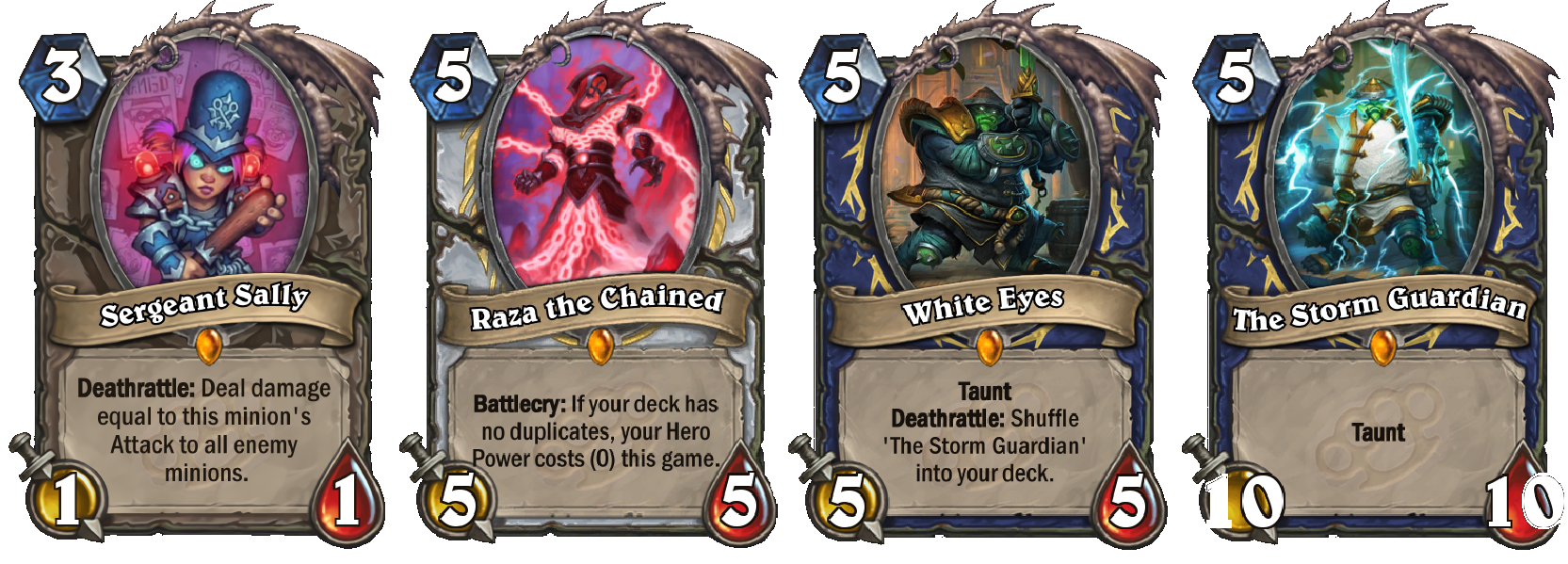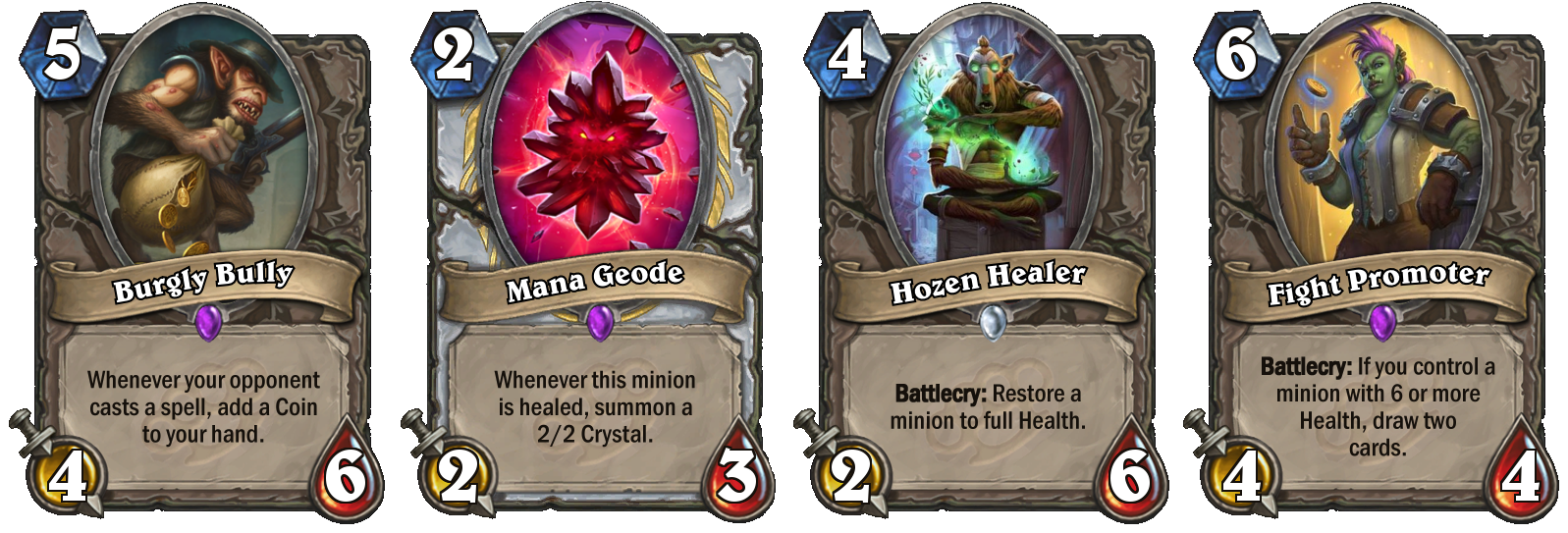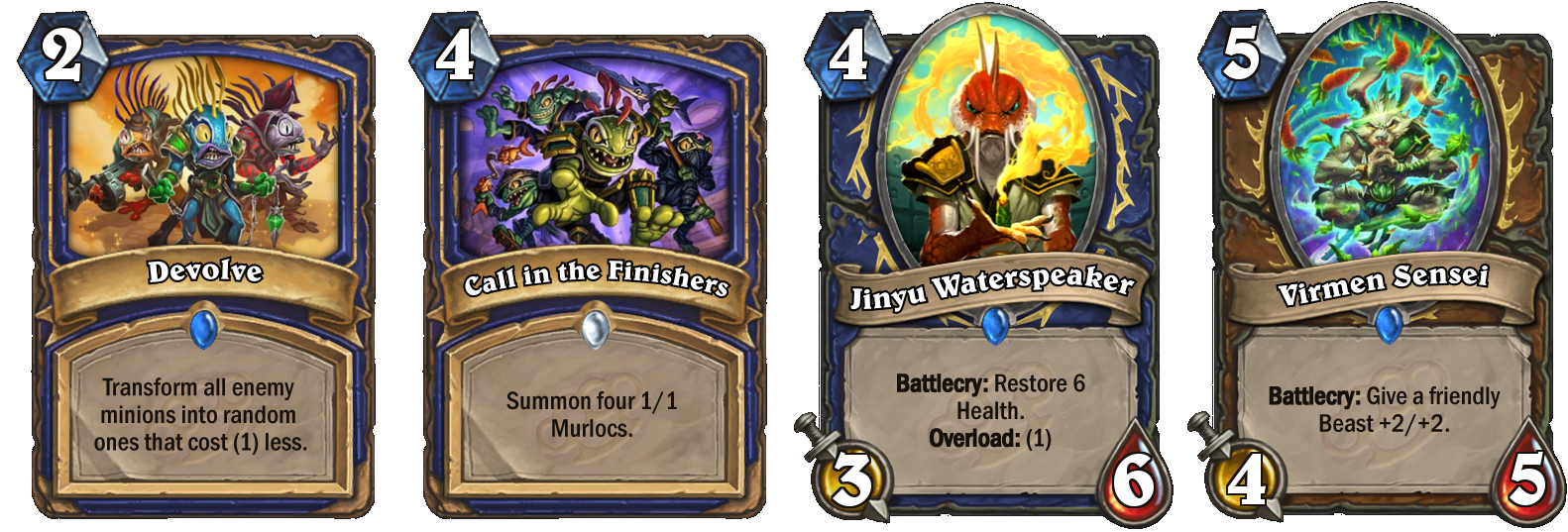With most of the key mechanics for Hearthstone's Mean Streets of Gadgetzan revealed, we've now hit the homestretch of our card review. This time, we look at cards that generally didn't fit neatly with the major themes of the cardset. Some of these are niche cards that fill in holes in different metas, some serve functions that aren't quite represented by additional cards, and some are just plain filler, the latter an inevitability in card games. After these cards, we just have Blizzard's final card drop to run down.

We start out with Sergeant Sally, a token that functions as an area-of-effect spell, similar to the way Explosive Sheep from Goblins vs. Gnomes works. The catch here -- isn't there always one? -- is that you have to buff her to get really effective board clears. But there's good news in that it doesn't have to be as part of the handbuff mechanic we've seen this set; she can also be buffed by on-board buffs from popular cards like Abusive Sergeant or Power Overwhelming. She's not powerful enough to stand on her own, but she could see tournament play as an extra board clear for midrange decks that could use an extra AOE.
Raza the Chained is the latest card encouraging players to make Reno-type decks, but is it good enough? The effect is a good one if you have a deck that gets a lot of value out of the hero power and it could have some use in a Control deck that feels it has enough one-offs, given that the class has a number of tech cards of which you may only play a single copy. Probably the biggest problem for this card in the tournament scene is that Dragon Priest is likely the stronger Priest deck and it's harder to justify the loss of copies of some of the very strong cards Priest received this release.
White Eyes was a bit controversial on reveal, simply because of the power of The Storm Guardian, the card that White Eyes shuffles into the deck. But White Eyes is a very slow card. You're not likely to keep him in your opening hand, which means you'll probably get him around Turn 10 on average and then typically draw The Storm Guardian when you have six or seven cards left in your deck. For a card that's this slow, this is the power level you need for it to be decent. White Eyes is a serious option for Control Shaman, but thankfully doesn't do anything for the oppressive Midrange Shaman that has dominated in recent months.

Burgly Bully is a bit like previous legendaries Troggzor the Earthinator and Trade-Prince Gallywix, both of which gave you a significant benefit from the opponent using spells. This card's cheaper, but the primary problem with the effect is that you generally want to stop the opponent from using spells, not simply get a benefit from them. That's why Loatheb from Curse of Naxxramas was such a commonly-played card and Troggzor and Gallywix weren't -- preventing your opponent from achieving their plan is better than getting rewarded for them doing so. Tomb Pillager gives you a coin as well, but the 5/4 body for four mana is more impactful and you almost always do get a coin, where you're not guaranteed anything here.
Mana Geode is a card with an effect that is theoretically powerful, but in practice, will be too hard to pull off consistently. It requires you to spend two mana to heal a minion that outright dies very easily. Given the heal has little value to a weak card like this, is two mana for a 2/2 really that exciting? Blood to Ichor also can summon a 2/2 slime, but at least the one damage it does can really have an impact and synergizes with cards like Execute. And it's half the cost. Mana Geode won't see play.
The problem with Hozen Healer is that healing a single minion to full health just isn't that impressive a tech effect. Shaman has a zero-mana card called Ancestral Healing that restores a minion to full health and also gives it taunt, and even at no cost other than having the card itself, it never sees play. The card synergizes with Auchenai Soulpriest to remove a minion, but Priest already has quite a few more efficient single-target removal spells. This card will get some play in Arena becomes sometimes the stat choices aren't that compelling, but you won't see this in any tournament.
Fight Promoter should be taken seriously, for the simple fact that any card with a powerful card draw mechanic has to be at least thought about. Triggering this card draws two cards, and with a card draw worth roughly 1.5 mana, that essentially makes this card a three-mana 4/4 from a value standpoint (and this card will come later in the game when you're most interested in that card draw). This may sound like I'm making a case for the card, but in the end, I don't think it's good enough. Six mana means you're not going to be playing many six-health minions the same turn and most of the playable cards that start out with that much health are priority removals for the opponent. For example, let's say you play Ragnaros on one turn and they have full health the next turn for your Fight Promoter. If the opponent was unable to remove Ragnaros last turn, they're probably in deep trouble anyway, and you're more interested in cards that seal the victory, not a 4/4 body with card draw.

For this trio of Shaman cards, we start off with Devolve, the cousin to the Evolve spell, which never really set off an archetype. While a useful defensive tool, it's a little too inconsistent because lower mana cost minions can frequently be worse for you than the more expensive ones. A fun card, but it really only will see play -- and even then only a chance -- if handbuff decks actually become tier one decks, as this card removes all those buffs from a full board.
Four 1/1s for four mana isn't impressive, but Call in the Finishers does have a place in a traditional Murloc deck if one becomes playable in Shaman. Murloc cards have a great deal of synergy, after all. It depends on that deck being good enough, though, and I can't see pros playing Murloc Shaman over Aggro, Midrange, or after this set release, Control Shaman.
Jinyu Waterspeaker is one of those cards that make Control Shaman more interesting, along with White Eye among others. Shaman has problems with survivability and while Healing Wave can heal a lot more, a good ending is reliant on winning a Joust, which is not an effect you want to count on when you're trying to stabilize. Waterspeaker gives you the six health no matter what, with a body capable of helping board control, which protects your life total as well.
Virmen Sensei has the benefit of Beast Druid being playable, at least for a few months; after that, some terrific cards like Savage Combatant rotate out of Standard, an event that will necessitate Druid getting some more good Beast Druid cards in the next expansion to remain relevant. The Sensei also has the advantage of being a ninja rabbit, which is cool. But the +2/+2 isn't powerful for a class that already can do that and it's not a beast itself, which is a big deal. Beast Druid wants to be playing Beast minions on turn four or five to prepare for Menagerie Warden, not dinking around with small buffs.

With Shadow Sensei I think we have a case of "not yet." Stealth is a fairly weak mechanic and for a four-mana 4/4 to see play, it generally has to have a crazy effect or some kind of crucial synergy. Rogue just doesn't have enough Stealth minions worth playing to get sufficient value from this card. But that doesn't mean it'll always be the case; with a few compelling Stealth minions, this card becomes a lot more interesting. See Burgle for Rogue, a card that only became more interesting in later expansions when cards that synergize with stolen cards made that at least a playable deck.
Daring Reporter has a lot of text for what will be, in most cases, a four-mana 4/4. That'll see play in Arena, but Mill-type decks aren't good enough at high-level play, so don't expect to see much of the Reporter at the World Championship next year. Outside of a very specific Mill deck -- which I'm not sure this would even take this -- it's just a weak card. Three-health minions are easy to remove by this point of the game and, even if unable to be removed, +1/+1 isn't strong enough to change an opponent's strategy to one that avoids drawing extra cards.
Gadgetzan Ferryman shares a lot in common with Youthful Brewmaster (as well as Ancient Brewmaster, which rarely is played) in that it flips minions back to the hand. Sometimes this is better than Youthful Brewmaster in that you can intentionally not combo it so that you're not forced to remove one of your own minions from the board in certain situations. But sometimes it's worse because you'll be unable to pull off the combo requirement. In the rare situations that you want to brew one of your own minions as an intentional part of your deck construction, usually a week or so after a powerful Battlecry minion is released, you'll probably choose the less volatile Youthful Brewmaster over this. This card would have been more interesting as a three-mana 2/3 that could also function as a Sap, in that it could also bump your enemy's minion to their hand. Maybe even at four mana.
This article is part of a series analyzing the cards in the Mean Streets of Gadgetzan Hearthstone expansion. For more, see part 1, part 2, part 3, part 4, part 5, part 6 and part 7.
